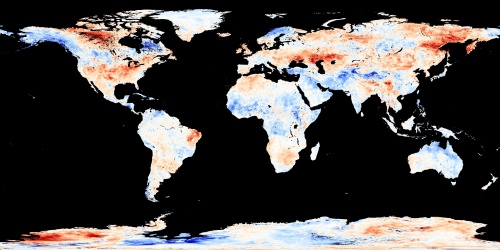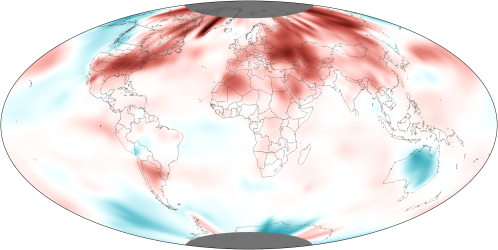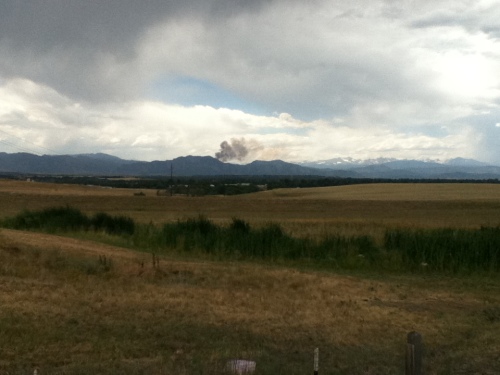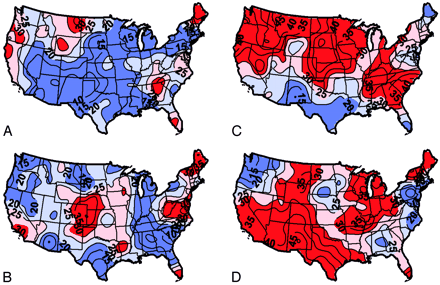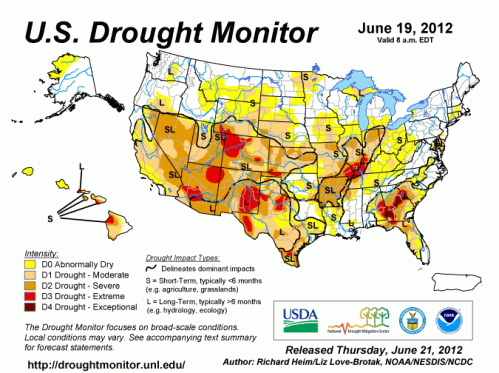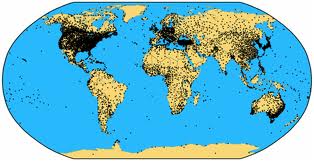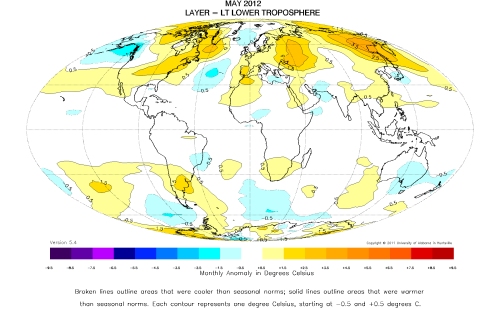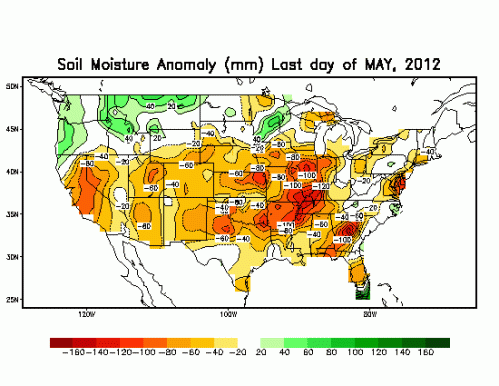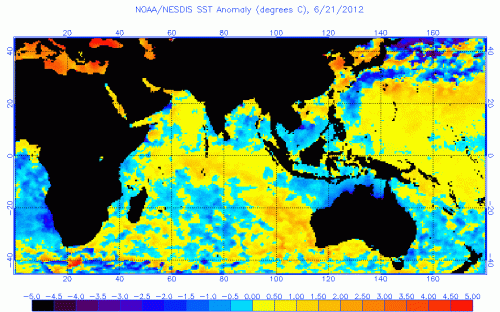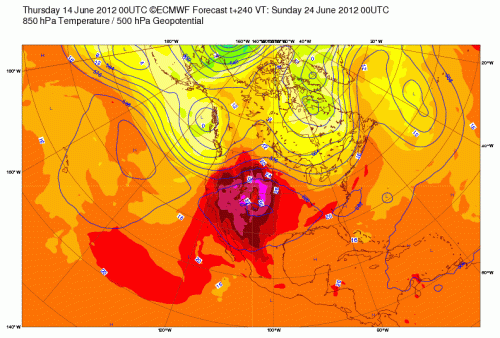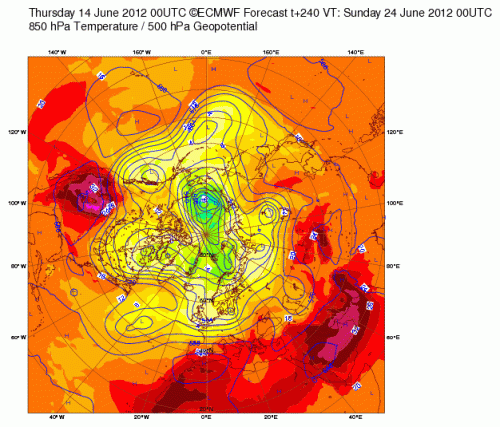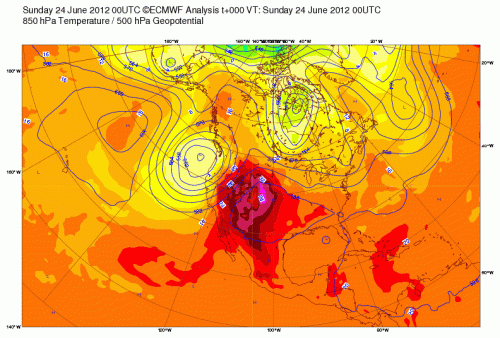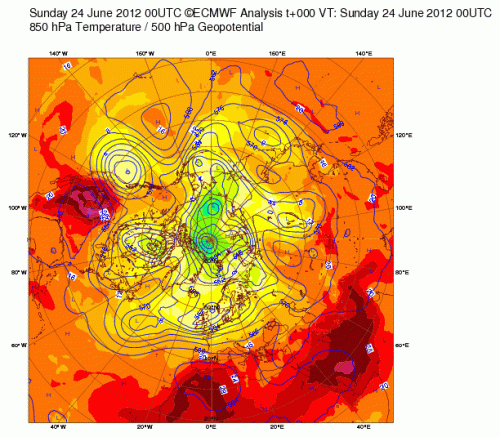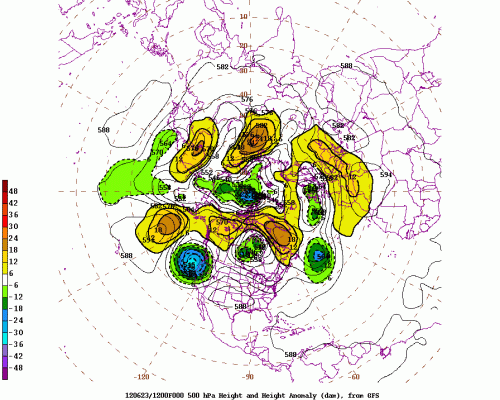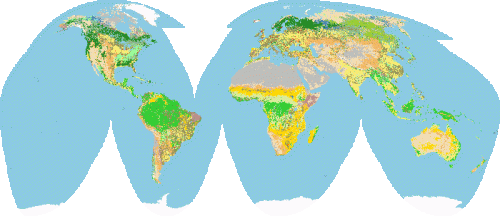I was alerted to an informative new paper on the issue of what is climate [h/t to Philip Richens]. The paper highlights the nonstationarity of climate as we presented in the papers
Pielke, R.A., 1998: Climate prediction as an initial value problem. Bull. Amer. Meteor. Soc., 79, 2743-2746.
As I wrote in that paper
“weather prediction is a subset of climate prediction and that both are, therefore, initial value problems in the context of nonlinear geophysical flow.’
“…..longer-term feedback and physical processes must be included. This makes climate prediction a much more difficult problem than weather prediction”.
As we wrote in
Rial, J., R.A. Pielke Sr., M. Beniston, M. Claussen, J. Canadell, P. Cox, H. Held, N. de Noblet-Ducoudre, R. Prinn, J. Reynolds, and J.D. Salas, 2004: Nonlinearities, feedbacks and critical thresholds within the Earth’s climate system. Climatic Change, 65, 11-38.
The Earth’s climate system is highly nonlinear: inputs and outputs are not proportional, change is often episodic and abrupt, rather than slow and gradual, and multiple equilibria are the norm.
The new paper on this subject is
“The Climate Is Not What You Expect” By S. Lovejoy and D. Schertzer 2012 [submitted]
The abstract reads [highlight added]
Prevailing definitions of climate are not much different from “the climate is what you expect, the weather is what you get”. Using a variety of sources including reanalyses and paleo data, and aided by notions and analysis techniques from Nonlinear Geophysics, we argue that this dictum is fundamentally wrong. In addition to the weather and climate, there is a qualitatively distinct intermediate regime extending over a factor of ≈ 1000 in scale. For example, mean temperature fluctuations increase up to about 5 K at 10 days (the lifetime of planetary structures), then decrease to about 0.2 K at 30 years, and then increase again to about 5 K at glacial-interglacial scales. Both deterministic GCM’s with fixed forcings (“control runs”) and stochastic turbulence-based models reproduce the first two regimes, but not the third. The middle regime is thus a kind of low frequency “macroweather” not “high frequency climate”. Regimes whose fluctuations increase with scale appear unstable whereas regimes where they decrease appear stable. If we average macroweather states over periods ≈ 30 years, the results thus have low variability. In this sense, macroweather is what you expect.
We can use the critical duration of ≈ 30 years to define (fluctuating) “climate states”. As we move to even lower frequencies, these states increasingly fluctuate – appearing unstable so that the climate is not what you expect. The same methodology allows us to categorize climate forcings according to whether their fluctuations decrease or increase with scale and this has important implications for GCM’s and for climate change and climate predictions.
The conclusion reads
Contrary to [Bryson, 1997], we have argued that the climate is not accurately viewed as the statistics of fundamentally fast weather dynamics that are constrained by quasi fixed boundary conditions. The empirically substantiated picture is rather one of unstable (high frequency) weather processes tending – at scales beyond 10 days or so and primarily due to the quenching of spatial degrees of freedom – to quasi stable (intermediate frequency, low variability) macroweather processes. Climate processes only emerge from macroweather at even lower frequencies, and this thanks to new slow internal climate processes coupled with external forcings. Their synergy yields fluctuations that on average again grow with scale and become dominant typically on time scales of 10 – 30 years up to ≈ 100 kyrs.
Looked at another way, if the climate really was what you expected, then – since one expects averages – predicting the climate would be a relatively simple matter. On the contrary, we have argued that from the stochastic point of view – and notwithstanding the vastly different time scales – that predicting natural climate change is very much like predicting the weather. This is because the climate at any time or place is the consequence of climate changes that are (qualitatively and quantitatively) unexpected in very much the same way that the weather is unexpected.
There are a series of informative comments on this paper by Judy Curry, Philip Richens, Shaun Lovejoy and others on the weblog All Models are Wrong post
In the insightful comment by Shaun Lovejoy on that weblog, he does write on one issue that I disagree with. Shaun writes
“….deterministic models (GCM’s) reproduce only weather and macroweather statistics (they do this quite well)”.
I agree on weather, but not on macroweather. Macroweather prediction has shown little, if any skill ; e.g. see the papers listed in my post
Kevin Trenberth Was Correct – “We Do Not Have Reliable Or Regional Predictions Of Climate”
As reported in that post, the papers reported on below document the failure to so far skillfully predict macroweather [what I refer to as climate, based on the definitions of climate as a system in NRC 2005].
1. Fyfe, J. C., W. J. Merryfield, V. Kharin, G. J. Boer, W.-S. Lee, and K. von Salzen (2011), Skillful predictions of decadal trends in global mean surface temperature, Geophys. Res. Lett.,38, L22801, doi:10.1029/2011GL049508
who concluded that
”….for longer term decadal hindcasts a linear trend correction may be required if the model does not reproduce long-term trends. For this reason, we correct for systematic long-term trend biases.”
2. Xu, Zhongfeng and Zong-Liang Yang, 2012: An improved dynamical downscaling method with GCM bias corrections and its validation with 30 years of climate simulations. Journal of Climate 2012 doi: http://dx.doi.org/10.1175/JCLI-D-12-00005.1
who find that without tuning from real world observations, the model predictions are in significant error. For example, they found that
”…the traditional dynamic downscaling (TDD) [i.e. without tuning) overestimates precipitation by 0.5-1.5 mm d-1…..The 2-year return level of summer daily maximum temperature simulated by the TDD is underestimated by 2-6°C over the central United States-Canada region.”
3. van Oldenborgh, G.J., F.J. Doblas-Reyes, B. Wouters, W. Hazeleger (2012): Decadal prediction skill in a multi-model ensemble. Clim.Dyn. doi:10.1007/s00382-012-1313-4
who report quite limited predictive skill in two regions of the oceans on the decadal time period, but no regional skill elsewhere, when they conclude that
“A 4-model 12-member ensemble of 10-yr hindcasts has been analysed for skill in SST, 2m temperature and precipitation. The main source of skill in temperature is the trend, which is primarily forced by greenhouse gases and aerosols. This trend contributes almost everywhere to the skill. Variation in the global mean temperature around the trend do not have any skill beyond the first year. However, regionally there appears to be skill beyond the trend in the two areas of well-known low-frequency variability: SST in parts of the North Atlantic and Pacific Oceans is predicted better than persistence. A comparison with the CMIP3 ensemble shows that the skill in the northern North Atlantic and eastern Pacific is most likely due to the initialisation, whereas the skill in the subtropical North Atlantic and western North Pacific are probably due to the forcing.”
4. Anagnostopoulos, G. G., Koutsoyiannis, D., Christofides, A., Efstratiadis, A. & Mamassis, N. (2010) A comparison of local and aggregated climate model outputs with observed data. Hydrol. Sci. J. 55(7), 1094–1110
who report that
“…. local projections do not correlate well with observed measurements. Furthermore, we found that the correlation at a large spatial scale, i.e. the contiguous USA, is worse than at the local scale.”
5. Stephens, G. L., T. L’Ecuyer, R. Forbes, A. Gettlemen, J.‐C. Golaz, A. Bodas‐Salcedo, K. Suzuki, P. Gabriel, and J. Haynes (2010), Dreary state of precipitation in global models, J. Geophys. Res., 115, D24211, doi:10.1029/2010JD014532.
who wrote
“models produce precipitation approximately twice as often as that observed and make rainfall far too lightly…..The differences in the character of model precipitation are systemic and have a number of important implications for modeling the coupled Earth system …….little skill in precipitation [is] calculated at individual grid points, and thus applications involving downscaling of grid point precipitation to yet even finer‐scale resolution has little foundation and relevance to the real Earth system.”
In response to my request to post on Shaun’s paper, he and I had a valuable e-mail interaction which I am posting below with his permission.
My initial query with Shaun’s reply embedded (as in the e-mail)
Hi Shaun
I was alerted by Philip to your excellent new paper
http://www.physics.mcgill.ca/~gang/eprints/eprintLovejoy/esubmissions/climate.not.26.6.12.pdf
Do I have your permission to post on my weblog an announcement about it along with the abstract and the conclusion? I would link to your pdf above where readers can obtain the full paper.
I have thought along the same lines as you have; e.g. see
Pielke, R.A., 1998: Climate prediction as an initial value problem. Bull. Amer. Meteor. Soc., 79, 2743-2746. https://pielkeclimatesci.files.wordpress.com/2009/10/r-210.pdf
Rial, J., R.A. Pielke Sr., M. Beniston, M. Claussen, J. Canadell, P. Cox, H. Held, N. de Noblet-Ducoudre, R. Prinn, J. Reynolds, and J.D. Salas, 2004: Nonlinearities, feedbacks and critical thresholds within the Earth’s climate system. Climatic Change, 65, 11-38. https://pielkeclimatesci.files.wordpress.com/2009/10/r-260.pdf
Pielke, R.A. and X. Zeng, 1994: Long-term variability of climate. J. Atmos. Sci., 51, 155-159. https://pielkeclimatesci.files.wordpress.com/2009/09/r-120.pdf
Pielke Sr., R.A., R. Wilby, D. Niyogi, F. Hossain, K. Dairuku, J. Adegoke, G. Kallos, T. Seastedt, and K. Suding, 2012: Dealing with complexity and extreme events using a bottom-up, resource-based vulnerability perspective. AGU Monograph on Complexity and Extreme Events in Geosciences, in press. https://pielkeclimatesci.files.wordpress.com/2011/05/r-365.pdf
If you approve, I plan to post for tomorrow.
Best Regards
Roger
P.S. Hi again Shaun
I was just alerted by Philip of your post on Tamsin Edward’s blog
http://allmodelsarewrong.com/limitless-possibilities/#comment-1397
and that of Judy Curry
http://allmodelsarewrong.com/limitless-possibilities/#comment-1238
and
http://allmodelsarewrong.com/limitless-possibilities/#comment-1257
On your comments, there is one I disagree with. You wrote
“….deterministic models (GCM’s) reproduce only weather and macroweather statistics (they do this quite well)”.
I agree on weather, but not on macroweather; eg. see the papers listed in
Shaun’s response
You’ve sent me links to a lot of new material, it will take me time to digest it and I apologize for not having cited your material, this can be corrected in the papers still in the submission process.
Let me make the above point clear. The statement “….deterministic models (GCM’s) reproduce only weather and macroweather statistics (they do this quite well)” only applies to control runs of GCM’s and to their statistics (e.g. spectra), and this out to about 10 year or so. I’m not sure if this is our point of disagreement, but this in no way implies that they give correct forecasts (or hind casts) – only that the broad type of variability (as characterized by statistical exponents such as spectral exponents) is not too different from the observations. Do you still disagree?
Since your submission is already available, I assume it is okay to post on your paper, but please let me know if otherwise. If you disagree with the perspective I have provided on macroweather prediction.
Shaun’s response
I’m not sure exactly which perspective you mean? are you referring to your criticism of decadal climate forecasts? If so, then I could somewhat modify the point I made above, I think that we would likely be in agreement.
Pease e-mail me why and I can post on my weblog too.
Shaun’s response
Yes, go ahead and post it if you like.
My further e-mail
Hi Shaun
This comment of mine in BAMS and associated weblog post might also be of interest to you
Pielke Sr., R.A., 2010: Comments on .A Unified Modeling Approach to Climate System Prediction.. Bull. Amer. Meteor. Soc., 91, 1699.1701, DOI:10.1175/2010BAMS2975.1, https://pielkeclimatesci.files.wordpress.com/2011/03/r-360.pdf
Roger
Shaun’s reply
Thanks Roger. Go ahead and cite all the stuff you want from our exchanges. I’ll take a look at your papers, and maybe then the exchanges will be a bit more precise! Thanks!
If one looks at the spectra of the NAO, the PDO or the Southern Oscillation Index, they don’t actually show a very big deviations from scaling behaviour, so that the ability or inability of the models to capture these process (which I admit are in the “macro weather” regime) will not affect very much this more fundamental question of the overall low unforced frequency behaviour (essentially the low frequency limiting behaviour of unforced GCM’s).
-Shaun
The new Lovejoy and Schertzer 2012, is a very important research contribution with major implications for the current IPCC assessment. While it could be used to infer too positive a statement about the skill of predicting macroweather (i.e. climate on multi-decadal time scales as I have defined it), it clearly documents the nonlinearity of the climate system and that weather, macroweather and climate (as defined in their paper) are initial value problems.
Their research also shows that there is a large over confidence in assessment reports, such as the IPCC, in being able to skillfully predict the human role in altering macroweather and longer term climate.
Shaun has also informed us that he will be publishing a book at Cambridge University Press with Daniel Schertzer this Fall titled “The Westher and Climate – Emergent Laws and Multifractal Cascades” that promises to be a very important much needed contribution to climate science. I look forward to learning from it!


